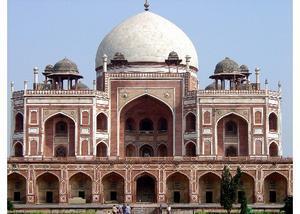Advertisement
Published: August 25th 2004

 Humayun's Tomb
Humayun's Tomb
The Marble WonderI live in Indian capital New Delhi, which is known for it’s historic monuments. Yet, I could not find time or urge to visit them for so long. When I finally got chance to visit one of the monuments,
Humayun’s Tomb in connection to a story I was doing, I was floored by the marvelous marble structure. I visited it again with my friend from USA.
Here, I am sharing my impression of this monument with travelblog readers.
When you first come face to face with the majestic
Humayun’s Tomb, you can’t help but say: "Oh, I’ve seen that somewhere! It looks like the
Taj Mahal, that famous monument to love."
Well, before you stretch your brain too far, let the truth be told. It’s the
Taj Mahal that looks like
Humayun’s Tomb. The red and white building is regarded universally as the precursor to and an inspiration for the Taj.
The beautiful structure, tucked away in New Delhi’s Nizammuddin area, has undergone a facelift. Believed to be a trendsetter as a garden mausoleum in the Indian subcontinent, this 16th century tomb of Mughal emperor Humayun now sports dazzling light displays, clean fountains, landscaped lawns, and wheelchair ramps.
It
not only houses the remains of Humayun but also the remains of nearly a hundred members of the Mughal clan.
On a hot Sunday evening, birds could clearly be heard singing. The clean, cool breeze was a welcome relief from the hot, crowded, and stifling Delhi streets outside the Tomb compound.
And, as every painting has its own creative master and touch-up artists, the Humayun’s Tomb was the brainchild of the emperor’s widow — Haji Begum — who built it in 1565 during Akbar’s reign at a then sum of Rs 15 lakh. The tomb is also probably the first of its kind which is sensitive to the needs of the physically challenged — a ramp at the garden’s entrance built specifically for wheelchair users as also bridges across water channels to make the garden accessible to the disabled.
Hidden from a full frontal view by the lofty double storeyed gateway, the tomb’s full grandeur is for the taking as the visitor first enters through the archway. What greets the sight is a w-i-d-e expanse of a red sandstone structure topped by a white marble dome, set in the centre of a huge square garden, enclosed by

 Humayun's Tomb
Humayun's Tomb
Seen From A Distancehigh walls on three sides, with the possibility of a river as its fourth boundary.
Cut into four squares by causeways and water channels — which give it the name
Chaar Bagh — each square of the garden is further divided into smaller squares by pathways — a feature ubiquitous to all Mughal era gardens. The amazingly advanced engineering skills of the era are amply demonstrated through the fountains, which work on an extremely simple and effective principle.
Entrance to the tomb's chamber is through the south entrance while the other three sides are covered with mesh wire in white marble. In the quietude of the central chamber lies the tomb, though the actual resting-place of Humayun is directly beneath in an underground chamber. Several members of the Mughal royal family lie buried in the mausoleum and many tombstones are seen on the terrace.
If you like to have a date with history, then this monument is something you should add to your tour itinerary.
Advertisement
Tot: 0.072s; Tpl: 0.008s; cc: 8; qc: 48; dbt: 0.0398s; 1; m:domysql w:travelblog (10.17.0.13); sld: 1;
; mem: 1.1mb

 Humayun's Tomb
Humayun's Tomb
 Humayun's Tomb
Humayun's Tomb
 Humayun's Tomb
Humayun's Tomb